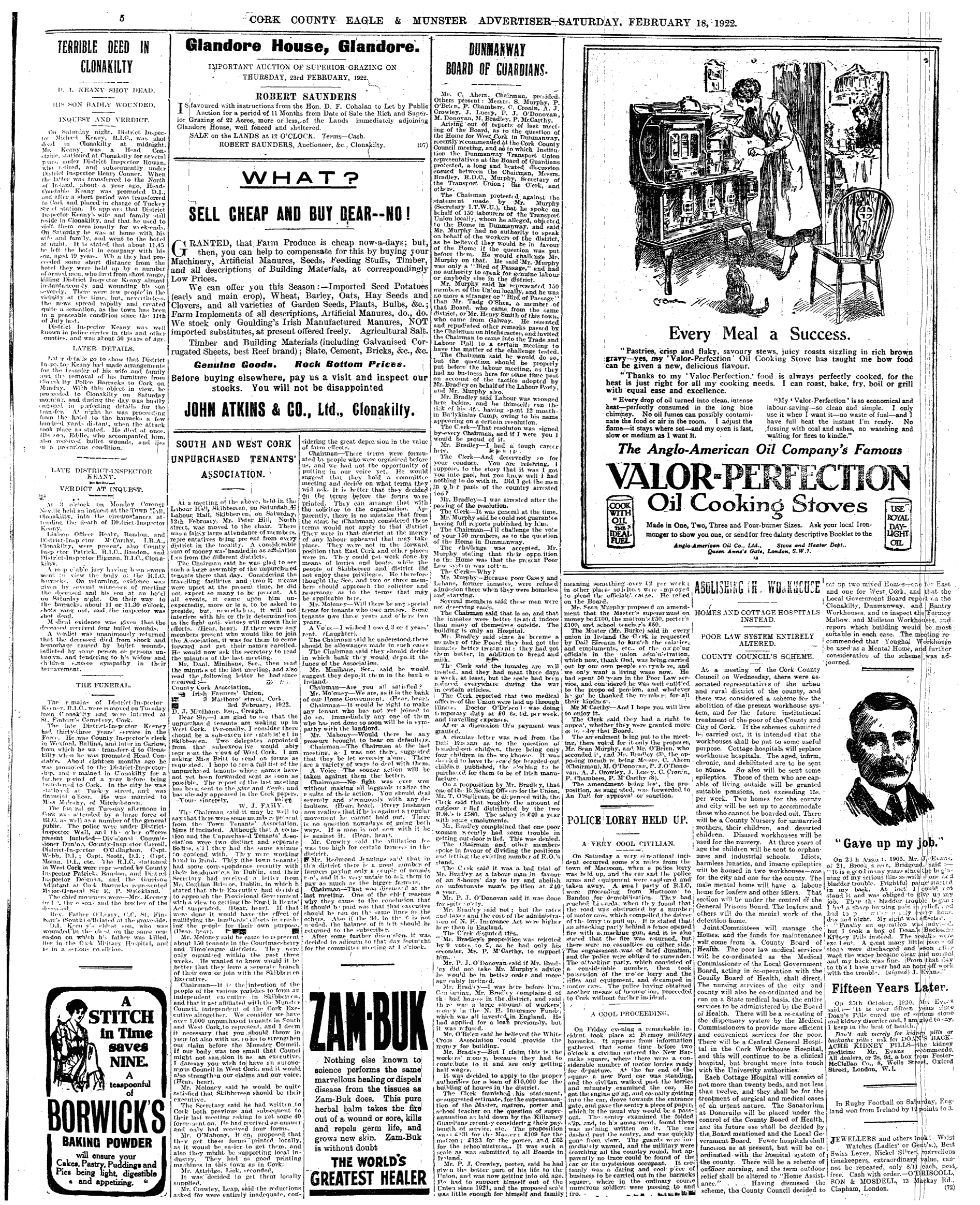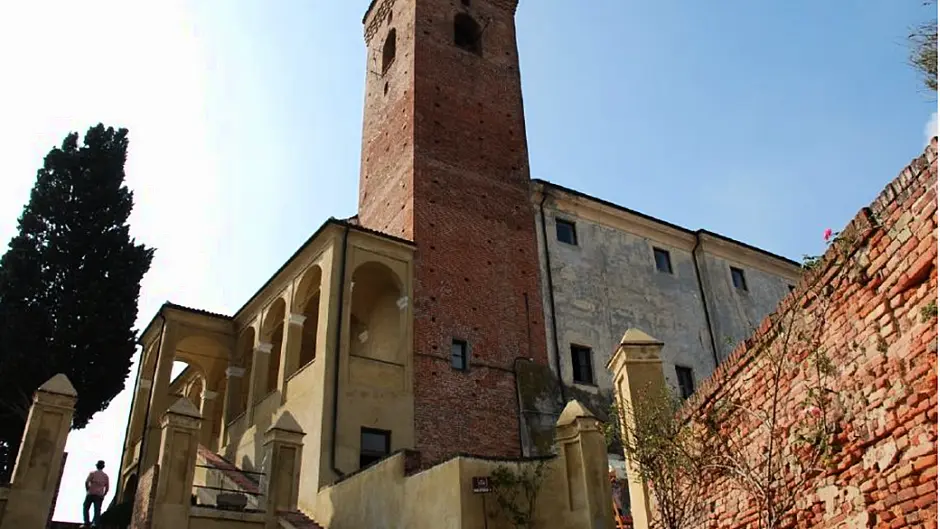Clonakilty’s John Keany was just a child when his RIC father was shot dead in the town. His family left for England but John would become a hero of Italy’s wartime resistance fight, awarded for his bravery
THE Skibbereen Eagle recorded that on Saturday February 11th, 1922, district inspector Michael Keany (53) of the Royal Irish Constabulary was in Clonakilty, making plans to move his family and furniture to Cork city, where he had been put in charge of Tuckey Street police station.
Around 11.30pm, as he was walking down Old Chapel Lane with his son Edward (19), armed men approached and opened fire. Inspector Keany was shot four times and died immediately. Edward was seriously wounded but survived. Insp Keany’s other son, six-year-old John Keany, born on April 14th, 1915, was safely indoors that night.
The children’s mother, Margaret Mulcahy, decided to take the family away from Cork. By 1925, they were living in Sundial Avenue, Norwood, south east London, and John was attending school, write Clodagh Finn and John Morgan in their new book The Irish in the Resistance: The Untold Stories of the Ordinary Heroes who resisted Hitler.
Having graduated in 1939 from Exeter University with a degree in French and German, Keany joined the Royal Irish Fusiliers at the outbreak of World War Two. A powerfully-built man, Captain Keany ‘had no intention of letting Ireland’s neutrality stand between him and the thrills of battle’, noted his mate, Sgt William Pickering.
In August 1941, Keany was posted to East Africa as personal assistant to the governor of the Italian colony of Eritrea. He was stationed there until May 1944, and became fluent in Italian. This proved a great advantage on February 4th, 1945, when he was parachuted into north-west Italy, with five other special agents. Their mission, codenamed ‘Operation Chariton’, was to help the Italian Resistance against the Germans, who had occupied the territory since 1943. Each man had refused the suicide tablets offered should they be captured.
The anti-fascist ‘Bandits of Cisterna’ collected the tubes dropped in the thick snow when the men landed. Each contained weapons – a Marlin sub-machine gun, a .45 Colt automatic pistol, a Commando fighting knife, and a comb with a hidden saw inside it. In a nearby wood, Keany was paired with Pickering, a wireless operator whose fascinating record of events over the next few months is quoted extensively by Finn and Morgan (William Pickering with Alan Hart, The Bandits of Cisterna, 1991).
While based at Tal and Luigia Biestro’s farm outside Monesiglio (Cuneo), Pickering used his crystal transmitter to send an encrypted message to London, saying they had arrived safely. The Germans picked it up: ‘Keany and I knew we were immediately at the top of the “wanted list” for the Germans in Monesiglio’, writes Pickering. The men continued to transmit at night, and by day hid in the barn – under four feet of leaves. Tal and Luigia had taken a huge risk protecting them: their neighbours had been shot dead, and their houses burned, for doing the same.
Partisans retrieved the men’s parachutes from the landing site, and under cover of darkness, the two men visited a seamstress, who promised she would make them a silk dressing gown and pyjamas.
Always the daredevil, Keany suggested they venture out one night to a bar situated right in the middle of a German garrison. After boozing the hours away, they zig-zagged back through farmyards and backstreets, giggling ‘like a pair of music hall drunks’.
Close escapes followed: while relieving themselves behind bushes, dozens of German soldiers passed within three metres of them. Another day, they were hiding so near to Mussolini’s Black Brigades that they could see the mud on their boots. Once, a German lorry approached while they were transmitting from a farmyard. As they frantically gathered their equipment, the aerial caught in a branch: the tell-tale wire would have meant ‘almost certain death for the farmer and his family’, write Finn and Morgan.
Suddenly, orders came from the National Committee of Liberation instructing them to head for Milan – a hazardous journey across rough terrain. At the Castle of Cisterna, the Bandits helped disguise them as peasants, and gave them a donkey and cartload of vegetables to conceal their radio and weapons. At Brusasco, on the way to Villanova d’Asti, they witnessed a train being blown up.
 The Skibbereen Eagle on February 18th, 1922 reported on the killing of John’s father, District Inspector Michael Keany in Clonakilty a week earlier.
The Skibbereen Eagle on February 18th, 1922 reported on the killing of John’s father, District Inspector Michael Keany in Clonakilty a week earlier.
When 120 men of the Justice and Liberty resistance forces joined them, they felt safer.
But progress was too slow for Keany: ‘I’d sooner be shot at going forward rather than standing still or retreating.’ Fateful words.
On the morning of March 8th, 1945, near Viale (just north of Villanova), 16 enemy troops headed directly towards them: ‘We believed ourselves to be 90 strong… It was not until they opened fire on us that we discovered most of [the] partisans had left, leaving… in all 12 men,’ recalled Pickering. The enemy fired, killing four. Among them was Keany.
Comrades wept at the loss of the ‘laughing Irishman’ who they had come to love during their five weeks together. Luigia Biestro wrote to Keany’s mother offering her deepest sympathy, and saying that during the short spell he was sheltering in their house, they got to know his ‘gentle goodness’ and ‘profoundly religious outlook’. When things were more settled, she planned to visit his grave in Cinaglio, near Asti. After the war, a memorial to John Keany was erected in Milan War Cemetery, and Italian partisans awarded him a medal for his bravery.
Sgt William Pickering went back to the seamstress in Monesiglio – to collect the promised silk pyjamas and dressing gown.
• The Irish in the Resistance: The Untold Stories of the Ordinary Heroes who resisted Hitler by Clodagh Finn and John Morgan is published by Gill Books and is priced at €19.99










